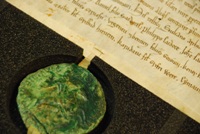Welsh seals provide window to our past

One of the seals held at the National Library which dates back to 1199.
18 March 2009
Historians at Aberystwyth and Bangor Universities will be reviewing over five thousand seals relating to Wales, held at the National Library of Wales, as part of a new research project. They will look at the seals anew, asking what they actually tell us about the people who commissioned them, interpreting how they saw themselves and wanted others to see them and what they can tell us about the society that produced them.
The project is funded by an Arts & Humanities Research Council (AHRC) research grant £490,000. Aberystwyth and Bangor Universities are collaborating their expertise for the work. The research project also includes digitising selected seals from the collection, making it more accessible to the general public and creating a travelling exhibition based on the collection. The project will also build upon excellent earlier work, including cataloguing by Welsh historians, most especially Dr David Williams.
At a time when only kings or the very powerful of the day could expect to commission a portrait or be pictured in a rare book, the image on your seal was one way of visually expressing your standing in society. The seal of a town corporation for example might show a castle tower and walls- and that might be because they were proud to be defined as a borough.
The project is being led by Professor Phillipp Schofield of the Department of History and Welsh History at Aberystwyth University. "One of the particular themes which I'm looking forward to exploring in this project relates to everyday exchange of property and the insights seals offer us into such dealing in medieval Welsh society, but there are so many other potential avenues for investigation including piety, personal expression, political affiliation and so on,” he said.
"There has been relatively little work done on this in any context, and this project presents us with an excellent opportunity to lead the way in the study of this important medieval source. The project will assemble a first-rate team of medievalists, including Dr Elizabeth New, a noted specialist in the use and interpretation of medieval seals, and a second research appointment to the project will be made later this year. This is all most exciting and will allow us to develop a highly valuable theme in the study both of seals and of medieval Welsh history," he added.
"In the past the seals have been appreciated for their pictorial beauty. We will be looking at the way the images were used to provide a sense of identity," explained Sue Johns of Bangor University's School of History, Welsh History & Archaeology.
"Seals moved from being something that only the highest in the land had at the beginning of the 12th century to a must-have status symbol by the end of the thirteenth. The twelfth-century marks a period of transition from an oral culture to a written one- so seals were being used more often to authenticate written land transactions and so forth. By the end of this period, many well to do farmers and merchants had their own seals, and indeed by the late middle ages most landholders, even of quite low social status, had them," she explained.
"Changes in culture and fashion can be traced in images on seals through the period, medieval women's wear changes as does the armour of knights seen in seals. They often depict heraldry or other symbolic images.
"One challenge facing us is that many of the seals have come adrift from their documents over the centuries. Having the document attached gives clues to the background of the owner of the seal and therefore helps with the interpretation. Even where we do have documents however there are many enigmas to be solved: A Medieval woman, Tangwystl, for example has the image of a fish on her seal, but we don't know why she chose that image; whether she had connections with fishing or fishmongering or any other reason to choose the image," she added.Professor Tony Claydon, Director of the Institute for Mediaeval and Early Modern Studies, which promotes collaborative research between Bangor and Aberystwyth, stressed that the award ‘Really demonstrates the benefits of our collaboration with Aberystwyth and reflects the substantial strengths of the two Universities in medieval history and culture.



